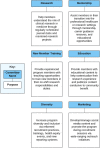Implementation and value of a student-run volunteer clinical research program at an academic medical center
- PMID: 35783458
- PMCID: PMC9237120
- DOI: 10.1002/emp2.12775
Implementation and value of a student-run volunteer clinical research program at an academic medical center
Abstract
Clinical research output in the emergency department (ED) continues to be constrained by limitations in funding for researchers, demands of patient care on ED providers, and difficulties in obtaining high-quality data. In response, several institutions have established programs in which student volunteers are integrated into department workflows to increase clinical research output and introduce pre-health students to careers in medicine. One such program, the student volunteer clinical research program, presently consists of over 40 undergraduate and post-baccalaureate student volunteers who screen, consent, and enroll patients into prospective studies in the ED of the University of California, Los Angeles (UCLA) Ronald Reagan Medical Center. The program is led by student coordinators who collaborate with departmental research staff and faculty. Our program is unique in that it is primarily run by the students themselves. Experienced student research associates facilitate recruitment through a competitive biannual application process, train new volunteers to perform on-shift research duties, and monitor participants for compliance with both hospital and program policies. Participation in the program provides students with exposure to frontline medical research, opportunities to observe clinical medicine, and access to a variety of program-specific resources including student-led committees, career development resources, and mentorship from peers, alumni, and faculty. This concept piece serves as a structural model for other institutions seeking to implement volunteer clinical research or bolster existing programs through increased student-led initiatives.
Keywords: emergency medicine; postgraduate; post‐baccalaureate; research; student, undergraduate; volunteer.
© 2022 The Authors. JACEP Open published by Wiley Periodicals LLC on behalf of American College of Emergency Physicians.
Conflict of interest statement
The authors claim no conflicts of interest.
Figures





Similar articles
-
The effectiveness of a student volunteer program for research in a pediatric Emergency Department.J Emerg Med. 2015 Jan;48(1):19-25. doi: 10.1016/j.jemermed.2014.06.039. Epub 2014 Sep 27. J Emerg Med. 2015. PMID: 25271177
-
Feasibility and outcomes of paid undergraduate student nurse positions.Nurs Leadersh (Tor Ont). 2006 Sep;19(3):e1-14. doi: 10.12927/cjnl.2006.19032. Nurs Leadersh (Tor Ont). 2006. PMID: 19830923
-
Implementation of a volunteer university student research assistant program in an emergency department: the nuts and bolts for success.CJEM. 2015 Sep;17(5):586-9. doi: 10.1017/cem.2015.79. Epub 2015 Jul 13. CJEM. 2015. PMID: 26166252 Review.
-
The professional benefits for volunteer research assistants in a pediatric emergency department.J Emerg Med. 2015 Mar;48(3):287-93. doi: 10.1016/j.jemermed.2014.06.038. Epub 2014 Sep 27. J Emerg Med. 2015. PMID: 25271184
-
Understanding Student-Run Health Initiatives in the Context of Community-Based Services: A Concept Analysis and Proposed Definitions.J Prim Care Community Health. 2022 Jan-Dec;13:21501319221126293. doi: 10.1177/21501319221126293. J Prim Care Community Health. 2022. PMID: 36164929 Free PMC article. Review.
References
LinkOut - more resources
Full Text Sources
